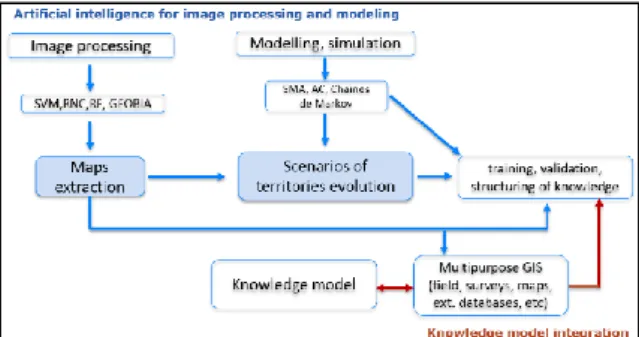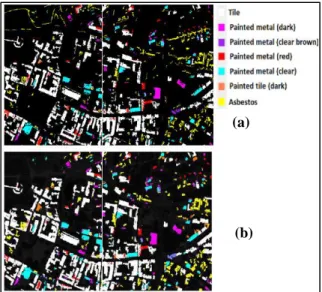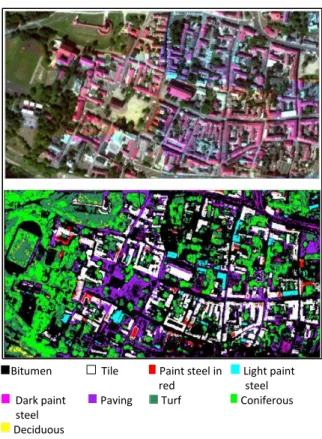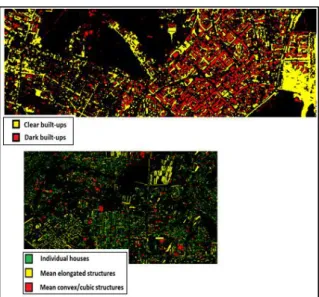HAL Id: hal-02120100
https://hal-amu.archives-ouvertes.fr/hal-02120100
Submitted on 5 May 2019
HAL is a multi-disciplinary open access
archive for the deposit and dissemination of
sci-entific research documents, whether they are
pub-lished or not. The documents may come from
teaching and research institutions in France or
abroad, or from public or private research centers.
L’archive ouverte pluridisciplinaire HAL, est
destinée au dépôt et à la diffusion de documents
scientifiques de niveau recherche, publiés ou non,
émanant des établissements d’enseignement et de
recherche français ou étrangers, des laboratoires
publics ou privés.
Knowledge Models and Image Processing Analysis in
Remote Sensing: Examples of Yakutsk (Russia) and
Kaunas (Lithuania)
Sébastien Gadal, Walid Ouerghemmi
To cite this version:
Sébastien Gadal, Walid Ouerghemmi. Knowledge Models and Image Processing Analysis in
Re-mote Sensing: Examples of Yakutsk (Russia) and Kaunas (Lithuania).
5th International
Con-ference on Geographical Information Systems Theory, Applications and Management, INSTICC;
University of Crete; IEEE GRSS; ACM SIGSPATIAL, May 2019, Heraklion, Greece. pp.282-288,
�10.5220/0007752202820288�. �hal-02120100�
HAL Id: hal-02120100
https://hal-amu.archives-ouvertes.fr/hal-02120100
Submitted on 5 May 2019
HAL is a multi-disciplinary open access
archive for the deposit and dissemination of
sci-entific research documents, whether they are
pub-lished or not. The documents may come from
teaching and research institutions in France or
abroad, or from public or private research centers.
L’archive ouverte pluridisciplinaire HAL, est
destinée au dépôt et à la diffusion de documents
scientifiques de niveau recherche, publiés ou non,
émanant des établissements d’enseignement et de
recherche français ou étrangers, des laboratoires
publics ou privés.
Knowledge Models and Image Processing Analysis in
Remote Sensing: Examples of Yakutsk (Russia) and
Kaunas (Lithuania)
Sébastien Gadal, Walid Ouerghemmi
To cite this version:
Sébastien Gadal, Walid Ouerghemmi. Knowledge Models and Image Processing Analysis in Remote
Sensing: Examples of Yakutsk (Russia) and Kaunas (Lithuania). 5th International Conference on
Geographical Information Systems Theory, Applications and Management, INSTICC - University of
Crete - IEEE GRSS - ACM SIGSPATIAL, May 2019, Heraklion, Greece. �hal-02120100�
Knowledge Models and Image Processing Analysis in Remote
Sensing: Examples of Yakutsk (Russia) and Kaunas (Lithuania)
Sébastien Gadal
aand Walid Ouerghemmi
bAix-Marseille Univ, CNRS, ESPACE UMR 7300, Univ Nice Sophia Antipolis, Avignon Univ, 13545 Aix-en-Provence, France
sebastien.gadal@univ-amu.fr, walid.ouerg@gmail.com
Keywords: Geographic Knowledge, Temporal Analysis, Geographic Ontologies, Spectral Databases, Spatial Modelling, Simulation, Artificial Intelligence, Image Processing, Remote Sensing.
Abstract: The use of geographic knowledge in remote sensing constitutes one of the fundamental base of the methodologies of image processing. Image processing, image analysis, and oriented-object recognition are based on the geographic knowledge. More specifically, the large panel of supervised classifications methods are one of the main example where geographic knowledge is necessary for both algorithms training and results validation. Recently, with the coming back of the artificial intelligence (AI) wave, it appears that a large spectrum of usually employed methodologies in remote sensing and image processing, are one of the main drivers of AI: machine learning, deep learning are the most effective’s examples. As well as many based processing algorithms like the Support Vector Machine (SVM) or the Random Forest (RF). However, despite the constant performances of the methods of calculus; the geographic knowledge’s determines the accuracy of recognition and classification in image processing and spatial modelling generated. In regard of the fast seasonal and annual landscape changes in the Arctic climate, and complex urban structures, Yakutsk and Kaunas cities contribute to the reflexion.
1 INTRODUCTION
The use of geographic knowledge in remote sensing constitutes one of the fundamental base of the methodologies of image processing. The efficiency of the maps generated, oriented objects-recognition, geographic object extractions and image analysis depend on the expert knowledge acquired by the analyst or/and the databases created: oriented-object spectral databases, object databases, maps, etc (e.g. Blaschke et al, 2008; Mennis and Guo, 2009). The accuracy of the model of knowledge implemented in image processing determines the capacity of recognition, as well as the results obtained establishes the quality of the spatial modelling of the landscape changes for example. Image processing, spatial modelling and geographic knowledge are interdependent. The performances of algorithms depends on the databases characterising the object to identify (spectral, morphological, etc.), which are implemented as learning bases and include expert
a https://orcid.org/0000-0002-6472-9955 b https://orcid.org/0000-0002-2119-7290
knowledge of the geographer (e.g. Huang and Jensen, 1997). These databases are used more and more for image analysis and interpretation (e.g. Durand et al, 2017; Weber et al, 2018). Algorithms used in artificial intelligence (AI) applied to remote sensing applications and more specifically to the field of geography process analysis, are mostly related to the image processing methods (Random Forest (RF), Support Vector Machine (SVM), neural network (NN), etc.) (e.g. Vopham et al, 2018). Therefore, there is a strong link between AI, image processing and analysis, especially with the last advances in terms of image acquisition and sensors development, involving an increase in terms of data complexity.
The approaches of spatial and territorial modelling and simulation base the processing on the panel of algorithms like the SMA, Markov chains, cellular automats, etc.). Algorithms used for the calculus as well as the methods in image processing remote sensing or in geographic modelling are not new. The performances of the infrastructures and
Gadal, S. and Ouerghemmi, W.
Knowledge Models and Image Processing Analysis in Remote Sensing: Examples of Yakutsk (Russia) and Kaunas (Lithuania).
In Proceedings of the 5th International Conference on Geographical Information Systems Theory, Applications and Management (GISTAM 2019), pages 282-288 I
architectures of calculus, combined to the implementations of massive data, and to the important progress on the formalisation of the knowledge in databases, are the last advances in AI and big data fields (e.g. Chi et al, 2016).
One of the issue focus on the object ontologies. Despise the lake of researches these since the 2000’s, knowledge models and spatial ontologies are one way to follow and reinvestigate (e.g. Breen, 2002). The formalisation of the geographic and social environments is generally structured on the expert knowledge (field missions, perception, etc.), the geographic databases (maps, census, etc.) organised and structured in GIS and databases (e.g. Ouerghemmi et al, 2017; Gadal and Ouerghemmi, 2016). Therefore, the processing approaches based on object ontologies (e.g. spectral, morphological, geometric characterisations), applies to the heterogeneity and complexity of urban objects (i.e. heterogeneous measurements). These objects are related to: (a) the form aspects (e.g. metric, geometric, morphology, textures, topology), (b) the biophysical characteristics (e.g. spectral signatures, spectral databases), and (c) the semantics (e.g. geolinguistics modelling based on identification, description of landscapes, human and societal uses, territorial knowledge of inhabitants, perception and conceptualisation of their home space/territory).
2 ISSUES IN URBAN REMOTE
SENSING
2.1 Multiplication of Earth
Observation Systems and
Geographic Databases
The fast grow of the Earth observation sensors combines the flood of remote sensing, geographic, environmental, or socioeconomic data. Flood and massive data characterise the present of the remote sensing: up to a few thousand spectral bands in hyperspectral imagery, high temporal repetitiveness of images taken (Meteosat 3rd generation, Sentinel 1
and 2, continuous covering on zone with UAV, etc.). Storage and heterogeneous massive data processing as well as the capacities of mutual enrichment by multi-source processing revealed new methodological challenges today. If the methods of fusion, machine learning, and deep learning are today established, the complexification of the knowledge structure including a large panel of heterogeneous data is still challenging.
The developed knowledge models are usually structured in accordance to data and knowledge integration in geographic information systems (GIS). Image-processing methods will rely on artificial intelligence for the extraction of information and knowledge in accordance to available geographic ontologies. The proposed approach is based on the joint use of knowledge databases and artificial intelligence for image processing and simulation (Fig.1).
The increase of the massive data with the use of hyperspectral data, high resolution centimetres satellite, airborne images and high temporal repetitiveness, requires automation of the processing sequences. For that purpose, artificial intelligence data processing methods (e.g. machine learning, deep learning, etc.) are increasingly used in image processing field.
Figure 1: The use of artificial intelligence based methods for image processing and management of massive data.
The need of implementing different types of knowledge to optimise the objects recognition process (e.g. training, learning and validation of the results) and to model the geographic and urban changes constitutes the second methodological block of the developed approach. For example, based-knowledge morphological databases using specific geometric rules were used to recognise and extract urban objects (Fig. 2).
Figure 2: Implementation of knowledge model for image processing and objects recognition.
The different sequence of image processing and modelling are related to the knowledge database for training the models, creating rules, and validating and interpreting the results.
2.2 Contribution of Knowledge
Databases in Remote Sensing
2.2.1 Knowledge Database Approaches
Result from the remote sensing image processing depends of the geographic knowledge formalised in databases or in ontological rules. Results of classification (e.g. land cover maps), segmentation or simulation will have no meaning without expert knowledge that will serve to both enhancement of the model training and improvement of the validation results. The classification accuracy of trees species identification made by airborne hyperspectral sensors was enhanced by the expert knowledge training compared to the learning made from spectral library of in-situ measurements of the same species (i.e. increase of Overall accuracy (O.A.) of up to 20%) (Fig.3) (Ouerghemmi et al, 2018a), the obtained O.A.(s) were < 25% for 11 vegetation species identification using the Spectral Angle Mapper (SAM) classifier. In (Ouerghemmi et al, 2018b), the usefulness of an expert knowledge for vegetation mapping was consolidated, and the mapping performance was enhanced when using a machine learning classifier jointly with the knowledge database, O.A. was up to 46% for 8 vegetation species identification.
morphometric databases provides the ability to detect the socio-economic functions of buildings. The implementation of other types of knowledge, for example the ontologies, is helpful in image processing for mapping and modelling the geographic changes. Ontological knowledge can be introduced in the form of rules, or can be used to build specific simulation scenarios and thus to make the simulation more reliable. Expert knowledge integration including a large panel of thematic must be explored for the future development in image processing approaches. As well, today, the main issues concerns essentially the standardisation of the data and knowledge oriented object databases like the morpho-spectral databases (e.g. Weber et al, 2018). The standardisation is one of the key-issue to implement and integrate the knowledge models in the methods of image recognition and geographic processing.
Figure 4: (a) Urban objects identification by spectral library, (b) morphological rectification for misclassifications compensation.
The introduction of other types of knowledge (e.g. ontological), could be very helpful in image processing in terms of mapping and modelling, indeed, ontological knowledge could be introduced in the form of rules, or could be used to build specific simulation scenarios and thus to make the simulation more reliable. In that context, expert knowledge of heterogeneous fields can be taken into consideration for future development of image processing methodologies. The issues will concern essentially the management and the standardisation of these data to make the integration in the processing frame easier and simpler for the end-user (e.g. Weber et al, 2018).
(a)
(b)
Figure 3: Vegetation species mapping over Kaunas city, at left mapping by spectral library, at right mapping by validation points of the expert knowledge.
In (Ouerghemmi et al, 2017; Gadal and Ouerghemmi, 2016), the use of morphological database for urban objects recognition in addition to spectral oriented-object database, allows to solve the misclassifications occurred when spectral database are only using in the classification (Fig.4). The use of
2.2.2 Artificial Intelligence Processing:
Rules, Training, Databases Building,
and Ontological Recognition
Artificial intelligence is a rising branch of interest, which is used more and more in remote sensing field. The goal is to take advantage of the available knowledge database in the processing step; the progress of the operations will follow certain ontologies. This will ensure the system autonomy thanks to the injection of intelligence into the process. Autonomous and intelligent systems permit to solve the different problems of image mapping, objects recognition, and simulation of different environmental phenomenon’s. In parallel, the knowledge database should follow certain structure and certain standardization directive, so that the different sources will be converted into ready to use format for the different algorithms and models.
3 APPLICATIONS OF
KNOWLEDGE MODELS IN
POST-SOVIET URBAN
ENVIRONEMENTS (SOME
RESULTS)
3.1 Kaunas: Morpho-Spectral
Database Learning for the
Recognition of Built-Ups and
Urban Vegetation
In the following section, we present some application related to the use of different types of knowledge models in urban remote sensing. The socio-economic building characterisation, building identification, and urban vegetation detection in two post-soviet cities: Kaunas in Lithuania (Baltic) and Yakutsk in the Eastern Siberia characterised by the Arctic climate.
The city of Kaunas is characterised by a large types of architectures and urban morphologies related to the different historical periods since the 15 century. Coexisting medieval, modern, Russian 19e century, Art modern, soviet and postmodern architectures and urban structures. The recognition and characterisation of the built-ups combines two knowledge’s database: the spectral database was used for urban classes’ identification, O.A. was up to 82% (Fig. 5), and geometric rules related to the morphology of the buildings for urban structures characterisation (Fig. 6). Application are made with an airborne VNIR
Rikola hyperspectral sensor with a GSD of 70 cm with 16 spectral bands.
Bitumen Tile Paint steel in red
Light paint steel Dark paint
steel
Paving Turf Coniferous Deciduous
Figure 5: Recognition based on the spectral database of urban materials (roof, human-made, vegetation).
Medieval (Kaunas Castle) 20e century (Art
Modern)
Gothic (end of the 15e century) 16e century
Modern period (18e-19e century)
Figure 6: Recognition of medieval, reconnaissance and modern buildings based on the geometric database.
The methodology applied integrates first, a threshold based segmentation according to the roof radiometry of the built-ups, and next geometric rules are used for the extraction of specific buildings or
urban structures. Several functions were identified in this context, which are individual houses, administrative building and cultural structures (Gadal and Ouerghemmi, 2016) (Fig. 6). The proposed methodology for urban objects extraction and characterisation was inspired by the research carried out in (Gadal and Ouerghemmi, 2015), from which, an airborne image over Toulouse (France) was used for the study. First, a spectral classification was carried to extract the urban frame using a SAM classifier, and second, textural attributes were used at different bands to extract three socio-economic classes, which are modern building, mean historical buildings, and mean residential buildings.
The figure 7 shows examples of the identification of urban structures using 4 different rules based on simple and complex geometric attributes, which are respectively pixel count, [elongation + area], [elongation + compactness] and [Minimum Bounding Rectangle (MBR)-fill Ratio + Area] (i.e. respect. Fig 2.a, 2.b, 2.c and 2.d). First rule allows detecting urban objects depending only on the attribute pixels count, which could be useful for detecting easily and roughly some specific structures in terms of size. Second rule allows extracting the urban structures of Kaunas city using both elongation and area attributes. Third rule allows detecting compact and elongated building corresponding to administrative and residential building using attributes compactness and elongation. Last rule permits the identification of specific morphologies using Objects MBR attribute and area attribute, most of the identified building corresponds to religious structures.
Figure 7: Recognition of urban structures using geometric rules (from the geometric urban oriented-object database).
3.2 Yakutsk: Multi-Temporal Urban
Landscape Changes and
Morpho-Spectral Database
Learning
This section presents some results of multi-temporal satellite imagery use for environmental change detection, urban frame identification, and morphological processing, in this context, a Sentinel 2 multi-temporal images were used over Yakutsk for inter-annual and inter-annual change detection estimation of built-up areas within the city (Gadal and Ouerghemmi, 2019). The used knowledge model include multi-temporal Sentinel-2A satellite imagery of several dates, high resolution SPOT 6 satellite imagery, biophysical indices, validation points of Google Street + field survey campaign, and morphological measurements of the different urban objects. Built-up areas were first extracted using the merging of different biophysical indices (Fig. 8.a), with O.A.(s) from 67% to 75%. In second step, built-up areas change was identified for two dates using Sentinel-2A imagery, the study revealed an increase of about 12% in terms of built-ups between 2 years interval. And finally morphological measurements of the extracted objects permits to identify main socio-economic classes of the city (Fig. 8.b), high resolution SPOT 6 imagery showed encouraging results in terms of morphological modeling of urban objects. This last example well illustrates the usefulness of a hybrid knowledge model for objects identification and characterisation, nevertheless the artificial intelligence part need to be further explored to better automate the processing sequence and to enhance the identification performance.
The perspectives behind the proposed methodology is focused on two main axis which are (a) the creation of a heterogeneous and standardized knowledge model for application to remote sensing issues, and (b) the development of a simulation strategy for urban sprawl based on the use of knowledge model. Indeed, the goal is to take advantage of many available heterogeneous sources of information in the simulation process. The usefulness of such knowledge model could be found at different levels of the simulation sequence, it permits to build coherent simulation scenarios, includes several biophysical indices (e.g. spectral signatures, spectral indices) in the simulation model, and bring some new features to the model like ontologies and topologies related to the our specific context and to our specific study zone. The availability of such knowledge model can enhance the model coherency and enhance the simulation
accuracy. Several studies have been already made in the literature; nevertheless, the used knowledge model was limited in terms of components.
Figure 8: Upper figure: urban frame identification over Yakutsk city, lower figure: urban function extraction by morphological attributes.
4 CONCLUSIONS
In this study, we presented an original methodological scheme based on the joint use of a hybrid knowledge model and artificial intelligence for remote sensing application purpose. Several application were already made using simple knowledge model composed of biophysical or morphological features or both at best. The idea behind the methodology is to enrich the knowledge model with several sources of information, which could be very different at first sight, but will better model the problem. The main issue will be related to the standardisation of such sources of information, so that the joint use of all the available sources could be easily considered by the end-user.
The field of application related to such knowledge model could be varied including objects mapping by remote sensing imagery, objects characterisation and identification, simulation of different environmental phenomenon (e.g. urban sprawl, urban degrowth, change detection, environmental phenomenon’s management). Such knowledge model, will requires the introduction of intelligence in both the structuring procedure of the model and in the processing sequence, including machine learning, deep learning and neuronal networks methods. The joint use of hybrid knowledge model coupled to the development
of intelligent rules and powerful training models will contribute to the enhancement of image processing and modelling methods and will constitute a new exploration field.
ACKNOWLEDGEMENTS
French National Agency through Polar Urban Centers (PUR, grant number ANR-15-CE22-0006) and through Hyperspectral Imagery for Urban and Environmental planning (HYEP, grant number ANR-14-CE22-0016) supported this research.
SPOT 6 and Sentinel 2 data got the support of the EQUIPEX GEOSUD (ANR-10-EQPX-20).
REFERENCES
Breen, C., Khan, L., and Ponnusamy. A., 2002. Image Classification Using Neural Networks and Ontologies. In Proc. 13th International Workshop on Database and
Expert Systems Applications, co-located with DEXA 2002, pages 98–102, Aix en-Provence, France.
Blaschke, T, Lang, S., and Hay, G.J., 2008. Object-Based
Image Analysis: Spatial Concepts for Knowledge-Driven Remote Sensing Applications, New York, NY,
USA:Springer-Verlag.
Chi, M., Plaza, A., Benediktsson, J.A., Sun, Z. Shen, J. and Zhu, Y., 2016. Big Data for Remote Sensing:
Challenges and Opportunities. Proceedings of the
IEEE, vol. 104, no. 11, pp. 2207-2219.
Durand, N. et al, 2007. Ontology-based object recognition for remote sensing image interpretation, In 19th IEEE
international conference on tools with artificial intelligence (ictai 2007), Patras, Greece, pp. 472-479.
Huang, X., and Jensen, J. R., 1997. A machine-learning
approach to automated knowledge-base building for remote sensing image analysis with GIS data.
Photogrammetric Engineering and Remote Sensing, 63, 1185–1194.
Gadal, S., 2012. Geographic Space Ontology,
Locus-Object, and Spatial Data Representation Semantic Theory. Universal Ontology of Geographic Space:
Semantic Enrichment for Spatial Data, IGI Global, pp.28-52, 9786-1-4666-032-27-1.
Gadal, S., and Ouerghemmi, W., 2015. Morpho-Spectral Recognition of Dense Urban Objects by Hyperspectral Imagery. In ISPRS Geospatial week, 28 Sept – 02 Oct,
La Grande-Motte, France.
Gadal, S., and Ouerghemmi. W., 2016. Morpho-spectral objects classification by hyperspectral airborne imagery. In Proceedings of the 8th Workshop on
Hyperspectral Image and Signal Processing: Evolution in Remote Sensing (WHISPERS), Los Angeles, CA.
Gadal, S., and Ouerghemmi. W., 2018. Multi-Level Morphometric Characterisation of Built-ups in Siberian
Sub-Arctic Urban Area: Yakutsk. In GEOBIA 2018:
From pixels to ecosystems and global sustainability, Montpellier, France.
Gadal, S.; Ouerghemmi, W., 2019. Multi-Level Morphometric Characterization of Built-up Areas and Change Detection in Siberian Sub-Arctic Urban Area: Yakutsk. ISPRS Int. J. Geo-Inf., 8, 129.
Mennis, J., and Guo, D., 2009. Spatial data mining and
geographic knowledge discovery—An introduction, Computers, Environment and Urban Systems, Volume
33, Issue 6, 2009, Pages 403-408, ISSN 0198-9715. Mozgeris, G. Juodkienė, V., Jonikavičius, D., Straigytė, L.,
Gadal, S. et al., 2018. Ultra-Light Aircraft Based
Hyperspectral and Colour-Infrared Imaging to Identify Deciduous Tree Species in an Urban Environment.
Remote Sensing, MDPI, 2018, 10 (10).
Ouerghemmi, W., Gadal, S., Mozgeris, G., Jonikavičius, D., and Weber, C., 2017. Urban objects classification by spectral library: feasibility and applications. In 2017
Joint Urban Remote Sensing Event (JURSE), Dubai, pp. 1- 4.
Ouerghemmi, W., Gadal, S., Mozgeris. G., 2018a. Urban Vegetation Mapping using Hyperspectral Imagery and Spectral Library. In IEEE International Geoscience and
Remote Sensing Symposium (IGARSS) 2018, Valencia, Spain. pp.1632-1635.
Ouerghemmi, W., Gadal, S., Mozgeris, G., and Jonikavičius, D., 2018b. Urban vegetation mapping by airborne hyperspectral imagery: feasability and limitations. In WHISPER 2018: 9th Workshop on Hyperspectral Image and Signal Processing: Evolution in Remote Sensing, Amsterdam, Netherlands. pp.245-249.
VoPham, T., Hart, J. E., Laden, F., and Chiang, Y. Y. (2018). Emerging trends in geospatial artificial
intelligence (geoAI): potential applications for environmental epidemiology. Environmental health: a
global access science source, 17(1), 40.
Weber, C., Aguejdad, R., Briottet, X., Aval, J., Fabre, et al., 2018. Hyperspectral Imagery for Environmental Planning. In Proc. of the IEEE International
Geoscience and Remote Sensing Symposium (IGARSS), Valencia (E).
Zakharov, M., Filippova, V., Savvinova, A., Pestereva, K., and Gadal, S., 2017. Recognition of Landscape Structures by Toponymical Map and Remote Sensing Analysis (Khangalassky district, Yakutia). In IX Arctic
Congress in Social Sciences (ICASS IX): "People and Place", Jun 2017, Umea, Sweden.
GISTAM 2019 - 5th International Conference on Geographical Information Systems Theory, Applications and Management




